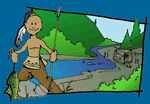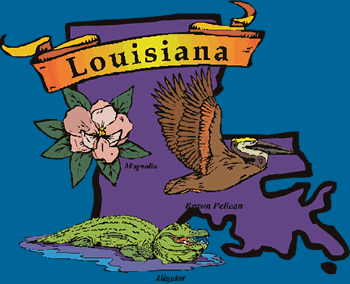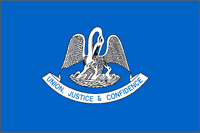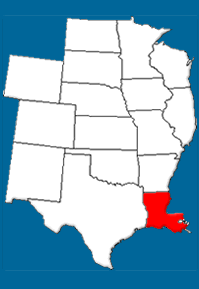


Geography and Landforms: Louisiana can be divided into three main geographic land areas. The East Gulf Coastal Plain consists of marshland east of the Mississippi River, and then rises slightly to rolling hills north of Lake Pontchartrain. The Mississippi Alluvial Plain is located along the Mississippi River and is characterized by ridges and hollows. This area includes the huge Mississippi Delta area covering about one-quarter of the state. This is the most fertile area of the state. Finally, the West Gulf Coastal Plain includes the area west of the Alluvial Plain and includes the highest point in the state, Driskill Mountain, near Arkansas. The lowest point in the state is in New Orleans and is 8 feet below sea level. This is the second lowest place in the United States next to Death Valley in California. |
 History:
Although Louisiana has at one time or another been under the flags of Spain, France, Britain, the United States, and even its own territorial flag, no one knows for sure which European explorer first set foot in Louisiana. In 1519, Alonso Alvarez de Pineda explored the northern shore of the Gulf of Mexico and may have been the first to discover the mouth of the Mississippi River. By 1542, Hernando de Soto was also exploring the area of the Mississippi. However, it was not until 1682 that Sieur de La Salle "took possession" of the area on behalf of the country of France and named it Louisiana in honor of France's King Louis XIV. The first permanent settlement in Louisiana was established in 1714 by Louis Juchereau de St. Denis, and was called Fort St. Jean Baptiste. Today, the settlement is present-day Natchitoches.
|
 Economy:
Louisiana is one of the nation's largest producers of cotton, sugarcane, rice, sweet potatoes and pecans. It is also a major producer of soybeans and corn. Louisiana is the only source of the Tabasco pepper, prized as a condiment across the world. Poultry is the largest livestock industry. The state is also the nation's largest producer of alligator hides and crawfish. Tourism is Louisiana's second largest industry after forestry (including paper-making and wood producing). Louisiana has more than 13.9 million acres of forests.
|
 First Inhabitants:
The earliest inhabitants of the area we now call Louisiana were probably nomads who hunted big game as early as 10,000 years ago. Archaeologists tell us that farming in the area began around 2,000 years ago with the cultivation of crops such as squash, sunflowers, beans and maize. Excavation at Poverty Point reveals that a highly organized society lived there from around 700 B.C.
|
Books Related To LouisianaBill and Pete to the Rescue - Tomie dePaola Feliiana Feydra LeRoux: A Cajun Tall Tale - Tynia Thomassie Fiddle Fever - Sharon Arms Doucet Honey Bea - Kim Siegelson Mr. Williams - Karen Barbour P is for Pelican: A Louisiana Alphabet - Anita Prieto Petite Rouge: A Cajun Red Riding Hood - Mike Artell Rent Party Jazz - William Miller Sounder - William Armstrong Sounder - William Armstrong Through My Eyes - Ruby Bridges |
Famous Citizens:
|
| Capital: | Baton Rouge |
| Entered Union: | April 30, 1812 |
| Population: | 4,649,676 |
| Area | 51,840 |
| Bird | Eastern Brown Pelican |
| Flower | Magnolia |
| Nickname: | Pelican State |
| Governor | Bobby Jindal |
Places to Visit in Louisiana: (Click the links to learn more.)
|



